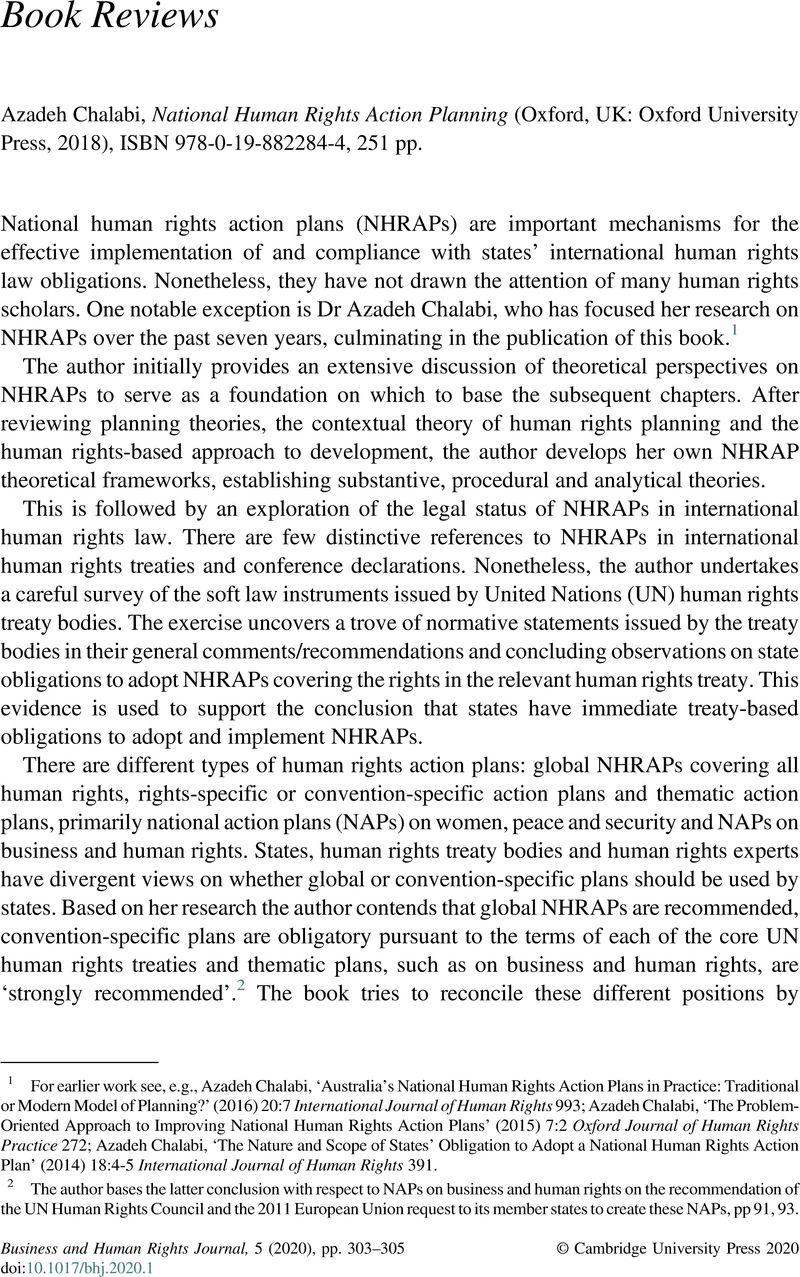No CrossRef data available.
Published online by Cambridge University Press: 03 February 2020

1 For earlier work see, e.g., Azadeh Chalabi, ‘Australia’s National Human Rights Action Plans in Practice: Traditional or Modern Model of Planning?’ (2016) 20:7 International Journal of Human Rights 993; Azadeh Chalabi, ‘The Problem-Oriented Approach to Improving National Human Rights Action Plans’ (2015) 7:2 Oxford Journal of Human Rights Practice 272; Azadeh Chalabi, ‘The Nature and Scope of States’ Obligation to Adopt a National Human Rights Action Plan’ (2014) 18:4-5 International Journal of Human Rights 391.
2 The author bases the latter conclusion with respect to NAPs on business and human rights on the recommendation of the UN Human Rights Council and the 2011 European Union request to its member states to create these NAPs, pp 91, 93.
3 See, e.g., Humberto Cantú Rivera, ‘National Action Plans on Business and Human Rights: Progress or Mirage?’ (2019) 4:2 Business and Human Rights Journal 213; Daniel Augenstein, Mark Dawson and Pierre Thielbörger, ‘The UNGPs in the European Union: The Open Coordination of Business and Human Rights?’ (2018) 3:1 Business and Human Rights Journal 1; Ryan Keefe, ‘The Value of National Action Plans for the Implementation of the United Nations Guiding Principles on Business and Human Rights’ (2017) 44 Exeter Law Review 106; Claire Methven O’Brien et al, ‘National Action Plans: Current Status and Future Prospects for a New Business and Human Rights Governance Tool’ (2016) 1:1 Business and Human Rights Journal 117; Sara Blackwell and Nicole Vander Meulen, ‘Two Roads Converged: The Mutual Complementarity of a Binding Business and Human Rights Treaty and National Action Plans on Business and Human Rights’ (2016) 6 Notre Dame Journal of International and Comparative Law 51; Damiano de Felice and Andreas Graf, ‘The Potential of National Action Plans to Implement Human Rights Norms: An Early Assessment with Respect to the UN Guiding Principles on Business and Human Rights’ (2015) 7:1 Journal of Human Rights Practice 40.
4 See Augenstein, ibid, 2–3; Methven O’Brien et al, ibid, 120; UN Human Rights Council, ‘Guiding Principles on Business and Human Rights: Implementing the United Nations’ “Protect, Respect and Remedy” Framework’, A/HRC/17/31, Annex (21 March 2011).
5 UN Working Group on Business and Human Rights, Guidance on National Action Plans on Business and Human Rights (Geneva, November 2016); The Danish Institute for Human Rights (DIHR) and the International Corporate Accountability Roundtable (ICAR), National Action Plans on Business and Human Rights Toolkit (2017 edn). The DIHR is Denmark’s national human rights institution.